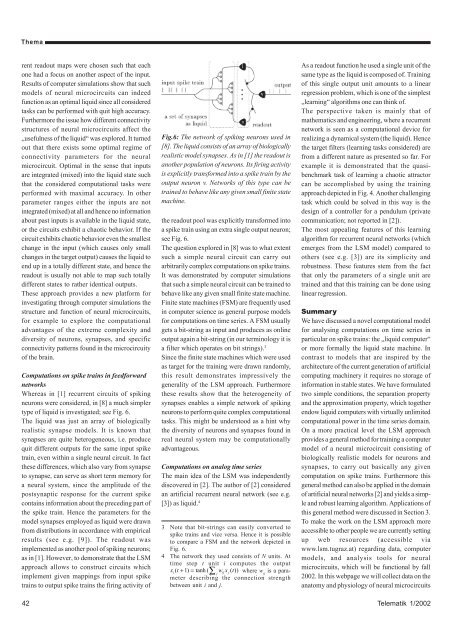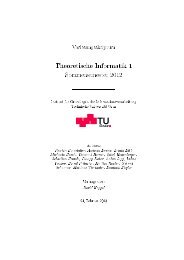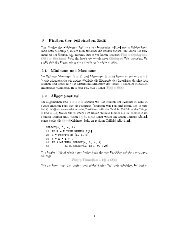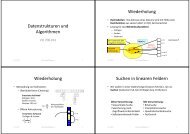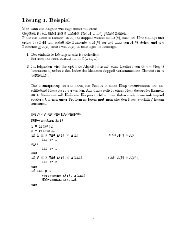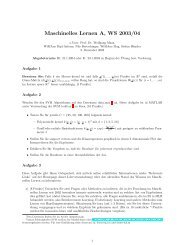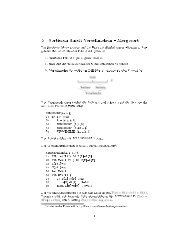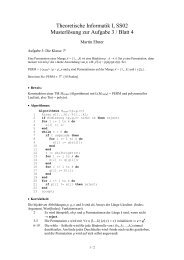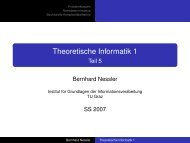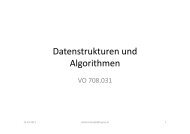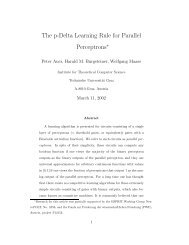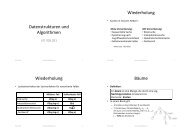Telematik 2/02 - Institut für Grundlagen der Informationsverarbeitung ...
Telematik 2/02 - Institut für Grundlagen der Informationsverarbeitung ...
Telematik 2/02 - Institut für Grundlagen der Informationsverarbeitung ...
Create successful ePaper yourself
Turn your PDF publications into a flip-book with our unique Google optimized e-Paper software.
Thema<br />
rent readout maps were chosen such that each<br />
one had a focus on another aspect of the input.<br />
Results of computer simulations show that such<br />
models of neural microcircuits can indeed<br />
function as an optimal liquid since all consi<strong>der</strong>ed<br />
tasks can be performed with quit high accuracy.<br />
Furthermore the issue how different connectivity<br />
structures of neural microcircuits affect the<br />
„usefulness of the liquid“ was explored. It turned<br />
out that there exists some optimal regime of<br />
connectivity parameters for the neural<br />
microcircuit. Optimal in the sense that inputs<br />
are integrated (mixed) into the liquid state such<br />
that the consi<strong>der</strong>ed computational tasks were<br />
performed with maximal accuracy. In other<br />
parameter ranges either the inputs are not<br />
integrated (mixed) at all and hence no information<br />
about past inputs is available in the liquid state,<br />
or the circuits exhibit a chaotic behavior. If the<br />
circuit exhibits chaotic behavior even the smallest<br />
change in the input (which causes only small<br />
changes in the target output) causes the liquid to<br />
end up in a totally different state, and hence the<br />
readout is usually not able to map such totally<br />
different states to rather identical outputs.<br />
These approach provides a new platform for<br />
investigating through computer simulations the<br />
structure and function of neural microcircuits,<br />
for example to explore the computational<br />
advantages of the extreme complexity and<br />
diversity of neurons, synapses, and specific<br />
connectivity patterns found in the microcircuity<br />
of the brain.<br />
Computations on spike trains in feedforward<br />
networks<br />
Whereas in [1] recurrent circuits of spiking<br />
neurons were consi<strong>der</strong>ed, in [8] a much simpler<br />
type of liquid is investigated; see Fig. 6.<br />
The liquid was just an array of biologically<br />
realistic synapse models. It is known that<br />
synapses are quite heterogeneous, i.e. produce<br />
quit different outputs for the same input spike<br />
train, even within a single neural circuit. In fact<br />
these differences, which also vary from synapse<br />
to synapse, can serve as short term memory for<br />
a neural system, since the amplitude of the<br />
postsynaptic response for the current spike<br />
contains information about the preceding part of<br />
the spike train. Hence the parameters for the<br />
model synapses employed as liquid were drawn<br />
from distributions in accordance with empirical<br />
results (see e.g. [9]). The readout was<br />
implemented as another pool of spiking neurons;<br />
as in [1]. However, to demonstrate that the LSM<br />
approach allows to construct circuits which<br />
implement given mappings from input spike<br />
trains to output spike trains the firing activity of<br />
Fig.6: The network of spiking neurons used in<br />
[8]. The liquid consists of an array of biologically<br />
realistic model synapses. As in [1] the readout is<br />
another population of neurons. Its firing activity<br />
is explicitly transformed into a spike train by the<br />
output neuron v. Networks of this type can be<br />
trained to behave like any given small finite state<br />
machine.<br />
the readout pool was explicitly transformed into<br />
a spike train using an extra single output neuron;<br />
see Fig. 6.<br />
The question explored in [8] was to what extent<br />
such a simple neural circuit can carry out<br />
arbitrarily complex computations on spike trains.<br />
It was demonstrated by computer simulations<br />
that such a simple neural circuit can be trained to<br />
behave like any given small finite state machine.<br />
Finite state machines (FSM) are frequently used<br />
in computer science as general purpose models<br />
for computations on time series. A FSM usually<br />
gets a bit-string as input and produces as online<br />
output again a bit-string (in our terminology it is<br />
a filter which operates on bit strings). 3<br />
Since the finite state machines which were used<br />
as target for the training were drawn randomly,<br />
this result demonstrates impressively the<br />
generality of the LSM approach. Furthermore<br />
these results show that the heterogeneity of<br />
synapses enables a simple network of spiking<br />
neurons to perform quite complex computational<br />
tasks. This might be un<strong>der</strong>stood as a hint why<br />
the diversity of neurons and synapses found in<br />
real neural system may be computationally<br />
advantageous.<br />
Computations on analog time series<br />
The main idea of the LSM was independently<br />
discovered in [2]. The author of [2] consi<strong>der</strong>ed<br />
an artificial recurrent neural network (see e.g.<br />
[3]) as liquid. 4<br />
3 Note that bit-strings can easily converted to<br />
spike trains and vice versa. Hence it is possible<br />
to compare a FSM and the network depicted in<br />
Fig. 6.<br />
4 The network they used consists of N units. At<br />
time step t unit i computes the output<br />
xi<br />
( t + 1)<br />
= tanh ( ∑ w ( ) ) where w is a para-<br />
j ij x j t<br />
ij<br />
meter describing the connection strength<br />
between unit i and j.<br />
As a readout function he used a single unit of the<br />
same type as the liquid is composed of. Training<br />
of this single output unit amounts to a linear<br />
regression problem, which is one of the simplest<br />
„learning“ algorithms one can think of.<br />
The perspective taken is mainly that of<br />
mathematics and engineering, where a recurrent<br />
network is seen as a computational device for<br />
realizing a dynamical system (the liquid). Hence<br />
the target filters (learning tasks consi<strong>der</strong>ed) are<br />
from a different nature as presented so far. For<br />
example it is demonstrated that the quasibenchmark<br />
task of learning a chaotic attractor<br />
can be accomplished by using the training<br />
approach depicted in Fig. 4. Another challenging<br />
task which could be solved in this way is the<br />
design of a controller for a pendulum (private<br />
communication; not reported in [2]).<br />
The most appealing features of this learning<br />
algorithm for recurrent neural networks (which<br />
emerges from the LSM model) compared to<br />
others (see e.g. [3]) are its simplicity and<br />
robustness. These features stem from the fact<br />
that only the parameters of a single unit are<br />
trained and that this training can be done using<br />
linear regression.<br />
Summary<br />
We have discussed a novel computational model<br />
for analysing computations on time series in<br />
particular on spike trains: the „liquid computer“<br />
or more formally the liquid state machine. In<br />
contrast to models that are inspired by the<br />
architecture of the current generation of artificial<br />
computing machinery it requires no storage of<br />
information in stable states. We have formulated<br />
two simple conditions, the separation property<br />
and the approximation property, which together<br />
endow liquid computers with virtually unlimited<br />
computational power in the time series domain.<br />
On a more practical level the LSM approach<br />
provides a general method for training a computer<br />
model of a neural microcircuit consisting of<br />
biologically realistic models for neurons and<br />
synapses, to carry out basically any given<br />
computation on spike trains. Furthermore this<br />
general method can also be applied in the domain<br />
of artificial neural networks [2] and yields a simple<br />
and robust learning algorithm. Applications of<br />
this general method were discussed in Section 3.<br />
To make the work on the LSM approach more<br />
accessible to other people we are currently setting<br />
up web resources (accessible via<br />
www.lsm.tugraz.at) regarding data, computer<br />
models, and analysis tools for neural<br />
microcircuits, which will be functional by fall<br />
20<strong>02</strong>. In this webpage we will collect data on the<br />
anatomy and physiology of neural microcircuits<br />
42 <strong>Telematik</strong> 1/20<strong>02</strong>


